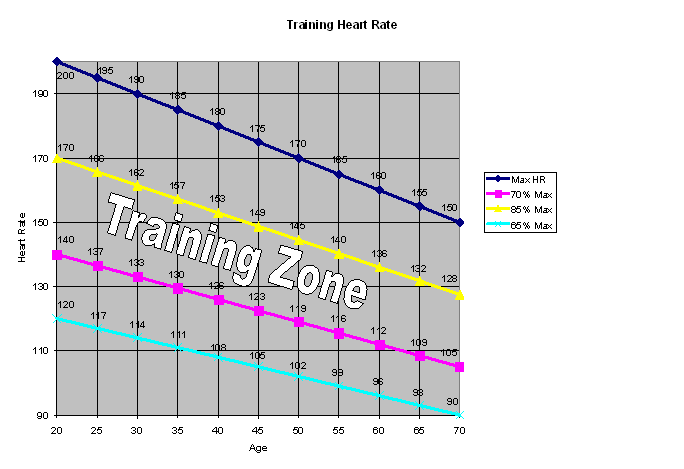|
Maximum
Heart Rate: 220 - Age
Training Zones
Healthy
Heart Zone (Warm up) --- 50 - 60% of maximum heart rate: The easiest
zone and probably the best zone for people just starting a fitness
program. It can also be used as a warm up for more serious walkers. This
zone has been shown to help decrease body fat, blood pressure and
cholesterol. It also decreases the risk of degenerative diseases and has a
low risk of injury. 85% of calories burned in this zone are fats!
Fitness Zone (Fat Burning) --- 60 - 70% of maximum heart rate: This
zone provides the same benefits as the healthy heart zone, but is more
intense and burns more total calories. The percent of fat calories is
still 85%.
Aerobic Zone (Endurance Training) --- 70 - 80% of maximum heart
rate: The aerobic zone will improve your cardiovascular and respiratory
system AND increase the size and strength of your heart. This is the
preferred zone if you are training for an endurance event. More calories
are burned with 50% from fat.
Anaerobic Zone (Performance Training) --- 80 - 90% of maximum heart
rate: Benefits of this zone include an improved VO2 maximum (the highest
amount of oxygen one can consume during exercise) and thus an improved cardiorespiratory system, and a higher lactate tolerance ability which
means your endurance will improve and you'll be able to fight fatigue
better. This is a high intensity zone burning more calories, 15 % from
fat.
Red Line (Maximum Effort) --- 90 - 100% of maximum heart rate:
Although this zone burns the highest number of calories, it is very
intense. Most people can only stay in this zone for short periods. You
should only train in this zone if you are in very good shape and have been
cleared by a physician to do so.

Measuring Your Heart Rate
Wearing a
heart rate monitor is an easy, accurate method of checking your heart
rate... but you don't have a monitor. Here is another easy way.
The easiest place to feel your own heart beat is the carotid artery. Place
your index finger on the side of your neck between the middle of your
collar bone and your jaw line. (You may also use the radial artery on the
under side of your wrist.) You can count the beats for a full 60 seconds
or count for 6 seconds and add a zero at the end. If you felt your heart
beat 14 times in 6 seconds the number would be 140 for a full 60 seconds.
Counting for only six seconds is a convenient method, of course it is more
accurate to count for the full 60 seconds. You can use several varieties
of this method (30 seconds x 2, 15 seconds x 4, etc.). The longer you
count the more accurate your reading. Whatever you choose, be consistent
in your method.
|
![]()

![]()
![]()